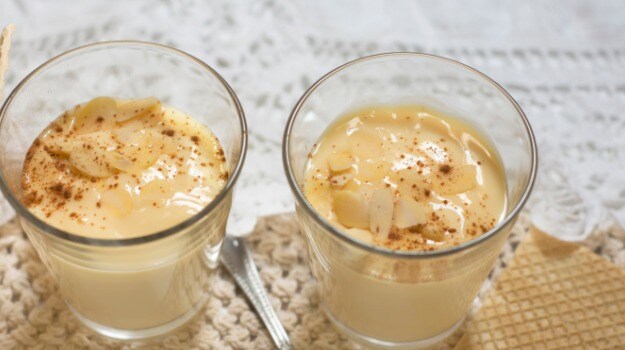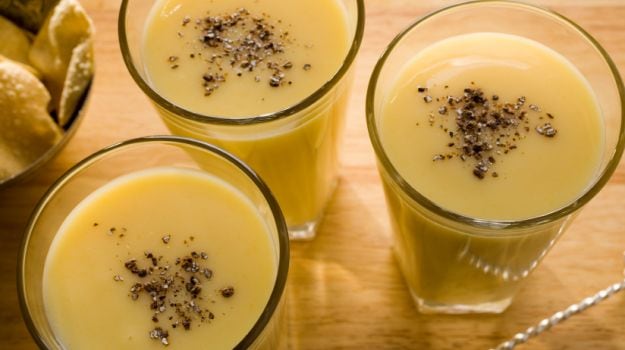It's that time of the year, when we all look forward to the festival of Holi. This also means it's time for thandai, the delicious festive drink. Usually made with milk, almonds, watermelon seeds, fennel seeds, pepper corn, rose petals, cardamom, khus seeds, saffron and sugar, some people also like to add dates, pistachio and some cream as well. And while it's said to be green in colour traditionally, most of the thandai I've had, which is also called sardai, gets its colour from the saffron strands. Colour aside, this drink, which is rarely made any other time of the year, becomes the object of our affection during Shivratri and Holi. Though it is popular in the northern part of the country, it is relished in other states as well.
Spend your Holi break in a city such as Bengaluru and you'll be asked at least a dozen times if you know where to find the best Thandai. In my opinion, the best ones are found in Varanasi, as most people who have had a taste of the drink there would concur, and you'll find them at Godowlia crossing. And this is also where you can find it with some bhaang (made with dried leaves and buds of cannabis), and it's legal too.

The Making of Thandai
Of course not everyone can make a trip to Varanasi during Holi, and there's special joy in making this chilled drink at home, and then guzzling it down, bottoms up, with perhaps even a bet on the table.
Asking my friends' mothers for recipes for thandai, I noticed that while kesar (saffron) is talked about a lot, not everyone actually uses it. For instance, one recipe has saunf (fennel) and peppercorn, which is something I've not had before. To make that, you need water, sugar, milk, almonds, watermelon seeds (or even papaya seeds), khus seeds, fennel seeds, cardamom powder, some rose water, whole peppercorns and rose petals (fresh or dried). All the ingredients, except for the cardamom powder, are soaked in water for a couple of hours, although I have been told overnight soaking is the best way to go.
Once the ingredients are soaked well, they are then made into a fine paste. The remaining water is then added to it, and the whole mixture is passed through a cloth strainer and collected in another vessel. You'll have some paste remaining in the strainer to which you can add a little more water to squeeze out more liquid. It's an arduous process, but at the end of it you'll ideally only have some husk remaining. Add the milk, sugar, cardamom powder and rosewater to the mix. Don't forget to boil the mixture, and once it cools, refrigerate it for a couple of hours before serving it.
Additions to the Recipe
The second recipe has cashews added in it too. And saffron replaces fennel. All the nuts and seeds are soaked in water for a few hours, and then blended with peppercorns, cardamom, rose petals (some even use gulkand instead of real rose petals) and rose water. What you should aim for is a smooth paste. The saffron needs to be separately soaked in a little bit of water for about half an hour too.
Once all the ingredients are prepped, add the saffron and the paste to the water. As for the sugar, you can either melt it in water first, or add it along with the other ingredients. This whole blend is cooked for about 15 minutes, and then brought down to room temperature. The milk is added in the end, mixed well, and then chilled for a while before serving. You can garnish this drink with a strand of saffron, a rose petal, and finely chopped pistachio or almonds.
If you like the taste of spices, you can even add cinnamon to the list of ingredients. Some people like their thandai thicker, in which case they use only milk and no water. But I always think thinning the milk down with a little water is a much better idea.
Have a happy and safe Holi everyone!
About the author:Priyadarshini Nandy would love to call herself the writer who "divides her time between London and Prague", but being able to call both Bengaluru and Kolkata her home is equally gratifying. As an independent journalist, she writes about food, theatre, travel, and more food, for various publications - new age and old school.
Disclaimer:The opinions expressed within this article are the personal opinions of the author. NDTV is not responsible for the accuracy, completeness, suitability, or validity of any information on this article. All information is provided on an as-is basis. The information, facts or opinions appearing in the article do not reflect the views of NDTV and NDTV does not assume any responsibility or liability for the same.












